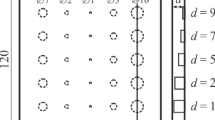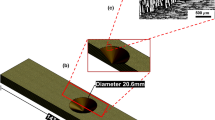Abstract
Carbon fiber reinforced polymer composites (CFRPs) are widely used as repairing patches in the aerospace, automotive and oil and gas industries. Defects in the process of repairing with patches are in most cases inevitable. In this study, the effects of depth and dimension of separation defects on the intensity of thermal effect were investigated and evaluated by pulse thermography. Specimens made for testing were carbon fiber sheets that were patched onto the aluminum plate. In order to model the defects in different layers, edges, and center of the patch, interlayer separation was done by inserting kepton sheets between two samples with 4 and 8 layers of carbon laminates. The manufactured samples containing defects were then heated by the use of flash light and observed using the IR camera. The thermographic images and intensity plots were then compared for each sample. The results showed that there is a minor difference between results obtained by thermal images and plots for both defect size and the thermal intensity in the 4 layer patch sample. As for the 8 layer sample, the defect size differences % and the thermal intensity in the interfacial layer between Al-CFRP and sixth layer in the CFRP were higher. It was also found that the base metal has a significant influence on the identification of defects.














Similar content being viewed by others
Availability of data and material
There is no more data than what was presented in the article.
Code availability (software application or custom code)
TNo code was used in this study.
References
Sabokrouh, M., Hashemi, S., Farahani, M.: Experimental study of the weld microstructure properties in assembling of natural gas transmission pipelines. Proc. Inst. Mech. Eng. Part B. 231(6), 1039–1047 (2017). https://doi.org/10.1177/0954405415579581
Sam-Daliri, O., Farahani, M., Faller, L.-M., et al.: Structural health monitoring of defective single lap adhesive joints using graphene nanoplatelets. J. Manuf. Processes. 55, 119–130 (2020). https://doi.org/10.1016/j.jmapro.2020.03.063
Meshkizadeh, P., Farahani, M.: Developing effective thermal signal processing to improve thermographic non-destructive inspection of metallic components. Nondestruct. Test. Eval. (2022). https://doi.org/10.1080/10589759.2021.2023521
Sam-Daliri, O., Faller, L.-M., Farahani, M., et al.: MWCNT–epoxy nanocomposite sensors for structural health monitoring. Electronics 7(8), 143 (2018). https://doi.org/10.3390/electronics7080143
Sam-Daliri, O., Faller, L.-M., Farahani, M., et al.: Structural health monitoring of adhesive joints under pure mode I loading using the electrical impedance measurement. Eng Fract Mech. 245, 107585 (2021). https://doi.org/10.1016/j.engfracmech.2021.107585
Garnier, C., Pastor, M.L., Eyma, F., Lorrain, B.: The detection of aeronautical defects in situ on composite structures using non destructive testing. Compos. Struct. 93(5), 1328–1336 (2011). https://doi.org/10.1016/j.compstruct.2010.10.017
Balageas, P.C.D.L., Krapez, J.C.: Pulsed photothermal modeUng of layered materials. J. Appl. Phys. 59(2), 348–357 (1986)
Parker, W.J., Jenkins, R.J., Butler, C.P., Abbott, G.L.: Flash method of determining thermal diffusivity, heat capacity, and thermal conductivity. J. Appl. Phys. 32(9), 1679–1684 (1961). https://doi.org/10.1063/1.1728417
Sripragash, L., Sundaresan, M.: Non-uniformity correction and sound zone detection in pulse thermographic nondestructive evaluation. NDT & E Int. 87, 60–67 (2017). https://doi.org/10.1016/j.ndteint.2017.01.006
Ishikawa, M., Ando, M., Koyama, M., Nishino, H.: Active thermographic inspection of carbon fiber reinforced plastic laminates using laser scanning heating. Compos. Struct. 209, 515–522 (2019). https://doi.org/10.1016/j.compstruct.2018.10.113
Poelman, G., Hedayatrasa, S., Segers, J., Van Paepegem, W., Kersemans, M.: Adaptive spectral band integration in flash thermography: Enhanced defect detectability and quantification in composites. Compos. Part B Eng. (2020). https://doi.org/10.1016/j.compositesb.2020.108305
Poelman, G., Hedayatrasa, S., Segers, J., Van Paepegem, W., Kersemans, M.: Multi-scale gapped smoothing algorithm for robust baseline-free damage detection in optical infrared thermography. NDT E Int. (2020). https://doi.org/10.1016/j.ndteint.2020.102247
Erazo-Aux, J., Loaiza-Correa, H., Restrepo-Giron, A.D., Ibarra-Castanedo, C., Maldague, X.: Thermal imaging dataset from composite material academic samples inspected by pulsed thermography. Data Br. 32, 106313 (2020). https://doi.org/10.1016/j.dib.2020.106313
Palumbo, D., Cavallo, P., Galietti, U.: An investigation of the stepped thermography technique for defects evaluation in GFRP materials. NDT E Int. 102, 254–263 (2018). https://doi.org/10.1016/j.ndteint.2018.12.011
Hu, C., et al.: LSTM-RNN-based defect classification in honeycomb structures using infrared thermography. Infrared Phys. Technol. (2019). https://doi.org/10.1016/j.infrared.2019.103032
Laureti, S., et al.: Delamination detection in polymeric ablative materials using pulse-compression thermography and air-coupled ultrasound. Sensors (Switzerland) (2019). https://doi.org/10.3390/s19092198
Alvarez-Restrepo, C.A., Benitez-Restrepo, H.D., Tobón, L.E.: Characterization of defects of pulsed thermography inspections by orthogonal polynomial decomposition. NDT E Int. 91, 9–21 (2017). https://doi.org/10.1016/j.ndteint.2017.05.003
Peeters, J., Ibarra-Castanedo, C., Sfarra, S., Maldague, X., Dirckx, J.J.J., Steenackers, G.: Robust quantitative depth estimation on CFRP samples using active thermography inspection and numerical simulation updating. NDT E Int. 87, 119–123 (2017). https://doi.org/10.1016/j.ndteint.2017.02.003
Vavilov, V., Chulkov, A., Smotrov, A., Smotrova, S., Moskovchenko, A.: Characterizing impact damage in GFRP/CFRP composites by determining thermal effusivity/diffusivity. Meas. Sci. Technol. 30(3), ab018e (2019). https://doi.org/10.1088/1361-6501/ab018e
Sreeshan, K., Dinesh, R., Renji, K.: Nondestructive inspection of aerospace composite laminate using thermal image processing. SN Appl. Sci. 2(11), 1–14 (2020). https://doi.org/10.1007/s42452-020-03619-9
Wen, B., et al.: Pulse-heating infrared thermography inspection of bonding defects on carbon fiber reinforced polymer composites. Sci. Prog. 103(3), 1–14 (2020). https://doi.org/10.1177/0036850420950131
Sripragash, L., Sundaresan, M.: Non-uniformity correction and sound zone detection in pulse thermographic nondestructive evaluation. NDT E Int. 87, 60–67 (2017). https://doi.org/10.1016/j.ndteint.2017.01.006
Chung, Y., Shrestha, R., Lee, S., Kim, W.: Thermographic inspection of internal defects in steel structures: analysis of signal processing techniques in pulsed thermography. Sensors (Switzerland) 20(21), 1–17 (2020). https://doi.org/10.3390/s20216015
Mac, V.H., Huh, J., Doan, N.S., Shin, G., Lee, B.Y.: Thermography-based deterioration detection in concrete bridge girders strengthened with carbon fiber-reinforced polymer. Sensors (Switzerland) 20(11), 1–19 (2020). https://doi.org/10.3390/s20113263
Marani, R., Palumbo, D., Galietti, U., Stella, E., D’Orazio, T.: Enhancing defects characterization in pulsed thermography by noise reduction. NDT E Int. 102, 226–233 (2018). https://doi.org/10.1016/j.ndteint.2018.12.009
Cruz-Aceves, I., et al.: Multiple active contours guided by differential evolution for medical image segmentation. Comput. Math. Methods Med. (2013). https://doi.org/10.1155/2013/190304
Pilla, M., Klein, M., Maldague, X., Salerno, A.: New absolute contrast for pulsed thermography. InProc. QIRT 1(1), 53–58 (2002). https://doi.org/10.21611/qirt.2002.004
Shepard, S.M., Rubadeux, B.A., Ahmed, T.: Automated thermographic defect recognition and measurement. AIP Confer. Proc. 373, 373–378 (2008). https://doi.org/10.1063/1.1302030
Omar, M., Hassan, M.I., Saito, K., Alloo, R.R.: IR self-referencing thermography for detection of in-depth defects Department of Mechanical Engineering, University of Kentucky Lexington KY 40506-0503 Toyota Motor Manufacturing North America Inc., pp. 1–17
Sinha, A., Sastry, O.S., Gupta, R.: Detection and characterisation of delamination in PV modules by active infrared thermography. NDT & E Int. 31(1), 1–16 (2016). https://doi.org/10.1080/10589759.2015.1034717
Ardebili, A., Hossein, M.A.: Non-destructive testing of delamination defects in GFRP patches using step heating thermography. NDT & E Int. (2022). https://doi.org/10.1016/j.ndteint.2022.102617
Ghabezi, P., Farahani, M., Shahmirzaloo, A., et al.: Defect evaluation of the honeycomb structures formed during the drilling process. Int J Damage Mech. 29(3), 454–466 (2020). https://doi.org/10.1177/1056789519860573
Farhang, M., Farahani, M., Enami, M.: Experimental study on the effects of friction stir spot welding process parameters on AL2024T3 joint strength. ADMT J. 14(4), 105–112 (2021). https://doi.org/10.30495/ADMT.2021.1922979.1280
Ghabezi, P., Farahani, M.: A cohesive model with a multi-stage softening behavior to predict fracture in nano composite joints. Eng. Frac. Mech. 219, 106611 (2019). https://doi.org/10.1016/j.engfracmech.2019.106611
Ghabezi, P., Farahani, M.: Experimental investigation of nanoparticles effects on cohesive model and bridging laws of mode I fracture in the adhesive joints. J. Adhes. Sci. Technol. 31(16), 1807–1823 (2017). https://doi.org/10.1080/01694243.2017.1284639
Ghabezi, P., Farahani, M.: Characterization of cohesive model and bridging laws in mode I and II fracture in nano composite laminates. J. Mech. Eng. Sci. 12(4), 4329–4355 (2018). https://doi.org/10.15282/jmes.12.4.2018.24.0370
Howell, J.R., Mengüç, M.P., Daun, K., Siegel, R.: Thermal radiation heat transfer. CRC Press, New York (2020)
Acknowledgements
All thermography tests were carried out at the Welding and Nondestructive Testing Applied Research Center of the University of Tehran (TWN) and hereby it is appreciated to provide the laboratory with the opportunity to conduct experiments and studies in this research.
Funding
This research was conducted by personal support and there is no funding.
Author information
Authors and Affiliations
Contributions
AA is the researcher who work under the supervision of MF.
Corresponding author
Ethics declarations
Conflicts of interest
Dr. Mohammadreza Farahani is the responsible author and there is no conflicts of interest in this research.
Ethics approval
Not applicable.
Consent to participate
Not applicable.
Consent for publication
Not applicable.
Additional information
Publisher's Note
Springer Nature remains neutral with regard to jurisdictional claims in published maps and institutional affiliations.
Rights and permissions
Springer Nature or its licensor holds exclusive rights to this article under a publishing agreement with the author(s) or other rightsholder(s); author self-archiving of the accepted manuscript version of this article is solely governed by the terms of such publishing agreement and applicable law.
About this article
Cite this article
Ardebili, A., Farahani, M. Delamination Defect Evaluation in CFRP Composite Patches by the Use of Active Thermography. J Nondestruct Eval 41, 61 (2022). https://doi.org/10.1007/s10921-022-00892-z
Received:
Accepted:
Published:
DOI: https://doi.org/10.1007/s10921-022-00892-z




